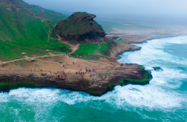Broad-based appeal and a growing reputation as an attractive destination for key markets suggest Oman could comfortably meet its long-term targets for the tourism industry, which include increasing visitor numbers to 11.7m by 2040.

Visitor numbers from Germany up more than two-fold
While the sultanate’s popularity is growing, data shows a marked rise in interest among visitors from Germany. The country has leapfrogged the UK and the Philippines to become Oman’s third-largest tourism source market, behind the GCC and India, according to figures from the National Centre for Statistics and Information. Arrivals from Germany reached 98,470 in the first four months of 2017, up from between 42,000 and 45,000 in the same period last year.
The increase in visitors from Germany has been buoyed by a strong showing in the cruise ship segment, with passenger numbers from the country up by almost 14,000 year-on-year. Data shows more cruise tourists from Germany entered Oman than from any other source market in the four-month period. Visitor numbers arriving in the sultanate from Germany by other means over the same period also rose by roughly 50,000, indicating a growing market for air travel.
Plans for long-term growth mapped out
Growth so far this year comes on the back of rapid expansion in the wider tourism industry in recent years. There are signs the country’s National Tourism Strategy (NTS), launched in June 2016, is beginning to further boost results. The government has pledged to invest OR20bn ($51.9bn) in the industry as part of the initiative, which aims create more than 500,000 jobs.
The strategy’s objectives include targeting 11.7m international and domestic tourists by 2040, with 5m sourced from overseas, although given current growth trajectories, these numbers may prove to be conservative. International visitors totalled 3m in 2016, up from 2.47m the previous year, according to media reports, marking a rise of 21%. Arrivals had already reached 1.3m in the first four months of 2017, putting the country on target to achieve a full-year total of almost 4m.
Tourism has also been identified as a strategic sector under the National Programme for Enhancing Economic Diversification (Tanfeedh) due to the significant potential it holds for economic growth. It contributed, on average, 2.2% per year to GDP between 2010 and 2015. One of Tanfeedh’s objectives is to increase the sector’s contribution from OR749m ($1.9bn) to OR1.5bn ($3.9bn) by 2020.
Attracting investment forms a key part of the government’s tourism development strategy, with the NTS aiming to source 88% of its $3bn strategy budget from the private sector. In 2016, 82% of investment channelled into the country’s tourism industry came from private sources, suggesting strong levels of confidence in the market.
Sharp focus on the high-end segment
The increase in visitor numbers can be attributed to a number of factors, including the long-term brand development strategy developed by the Ministry of Tourism (MoT), regional geo-political factors and global trends in luxury tourism.
In 2010, the sultanate launched its first global branding campaign under the tagline “Beauty has an address – Oman”, and has since continued to invest in marketing the country as a premium destination.
An emphasis on quality and authenticity dovetails with global trends in luxury travel. According to Euromonitor International’s “Global Luxury Travel Trends Report” for 2017, “… conspicuous consumption is giving way to conscientious consumption and more meaningful and ‘authentic’ luxury travel experiences.”
Security a major plus for travellers
Oman’s reputation as a safe destination is also contributing to the increase in European visitors. The “World Travel Trends Report” 2016/17 by IPK International and ITB Berlin highlighted both a rise in outbound travel from Europe and a tendency for European travellers to choose destinations perceived as safe. German outbound travel topped the continental average increase of 2.5%, recording 4% growth in the first eight months of 2016.
To maintain momentum in the sector, later in 2017 the MoT is expected to roll out a digital marketing campaign targeting several markets, including Europe, China and India.
The country also plans to build on its reputation as a provider of conscientious luxury by promoting responsible tourism through the development of green lodges and heritage homes. Its efforts in digital marketing were acknowledged in April when the MoT won the regional “Best Usage of Social Media” award at the Arab Travel Market Expo 2017, which took place in Dubai.


